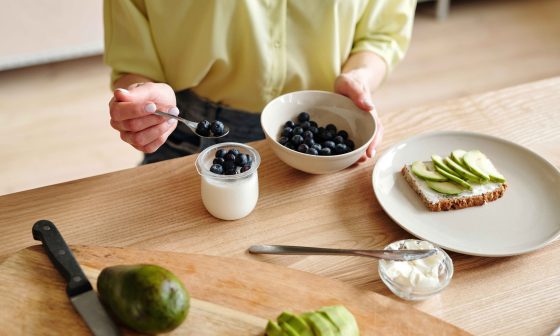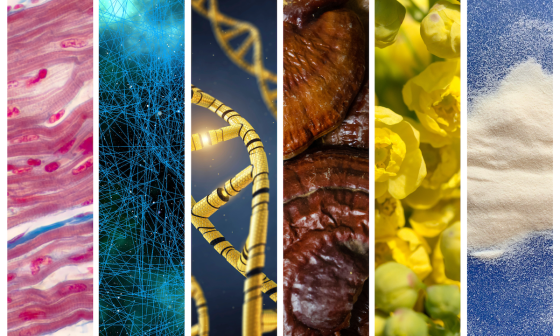Cordyceps (Ophiocordyceps sinensis) is a mushroom that’s not technically a mushroom but in fact a rare caterpillar fungus. Found only in high-altitude regions of northeastern India, cordyceps contains bioactive components such as polysaccharides, cordycepin, and cordycepic acid which make it an incredibly potent functional mushroom with a huge roster of health benefits.
Benefits
Supports Athletic Performance and Energy
Cordyceps’ can improve athletic performance and stamina via its ability to absorb oxygen and use it more efficiently. This has been demonstrated through multiple studies that reference cordyceps’ ability to improve oxygen uptake and the body’s supply of ATP, the main source of energy for cells during exercise. (1)
Longevity
The antioxidant properties of cordyceps support healthy aging by fighting free radicals in the body to protect cells from damage which can contribute to many conditions related to aging. (2)
Blood Sugar Support
Cordyceps show a promising ability to have a positive effect on insulin levels in the body, which help keep blood sugar levels in check. (4)
Immune Boosting
Cordyceps contain Beta-D-Glucans, shown to help modulate the immune system, support a healthy inflammation response and reduce tumour cell growth. (7)
Heart Health
Higher levels of LDL (bad cholesterol) can cause build-up in the arteries, which is linked to an increased risk of cardiovascular conditions. (5) Cordyceps sinensis have been shown to lower LDL levels in the blood.
Libido
Studies suggest cordyceps’ libido-enhancing properties may stem from its hormone-supportive actions. Studies done on both men and women have referenced its ability to increase libido and sexual performance. (3)
Cognitive Support
Animal studies have shown cordycepin (the active ingredient) to be neuroprotective and theorize that cordyceps can reduce occasional stress. (8) Cordyceps are also known as a stimulating adaptogen, meaning they can be a lot more energizing compared to other more restorative adaptogens.
TCM
Considered a potent kidney jing tonic in TCM, cordyceps is said to be useful for respiratory complaints, physical tiredness, and for those with a weak constitution. It nourishes yin, boosts, yang, and supports kidney essence.

How to Supplement
To reach the clinical benefits mentioned above, typical dosages range from upwards of 2000 mg. We recommend adding a dose of 500 mg to your custom formula to reap some of the benefits of cordyceps and work to increase with the support of a practitioner, especially if you’re looking to increase athletic performance or boost the immune system. Cordyceps along with other adaptogens can be taken alone or with food depending on your personal preference. If your custom formula has fat-soluble nutrients, or if it’s fully loaded, we recommend taking it with food.
We suggest taking cordyceps in the morning since it can support energy, limit fatigue and boost cognitive performance.
It’s one of the most expensive mushrooms in the world because it’s unable to be cultivated which has only fuelled demand on a set supply.
Types
Cordyceps Sinensis
Cordyceps sinensis (now known officially as Ophiocordyceps sinensis) is the most well-known species of cordyceps. It’s the one that infects the caterpillar of the Hepialus moth and grows at high elevations in Tibet and the Chinese provinces of Sichuan, Yunnan, Qinghai and Gansu. It’s one of the most expensive mushrooms in the world because it’s unable to be cultivated which has only fuelled demand on a set supply.
Cordyceps Mycelium CS-4
The mycelium of cordyceps sinensis can in fact be cultivated and research has indicated that it contains the same active compounds as the fruiting body if cultivated under the right conditions. There are two methods used to produce cordyceps mycelium:
- CS-4 grown as liquid culture: The mycelium is grown in a nutrient-rich liquid culture, dried, and pulverized into a powder that is 100% mycelium. This method ensures the end product has a similar compound profile to the fruiting body.
- CS-4 grown as mycelium on grain: The mycelium is grown out on grain and once colonized, is dried and pulverized. We carry Cordyceps Sinensis that is grown on organic oat substrate which is most comparable to the natural form without the microbial concerns of handling insect larvae.
Cordyceps Militaris
Cordyceps militaris has a compound profile that’s similar to C. sinensis and the two have been used interchangeably for years. Recently, scientists have been able to cultivate the fruiting body of C. militaris making it a much more affordable option. Since the method of cultivation doesn’t require the use of insects, it can be considered vegan, delivering most of the same benefits as C. sinensis without the higher price tag or ecological consequences of overharvesting.
Evidence
Statistically Significant Increase in Athletic Performance
Cordyceps can improve exercise performance in healthy older patients by improving respiratory and metabolic functioning. A study conducted on 20 healthy older individuals aged 50-75 using a control group and another group who took 999 mg of CS-4 per day found that after 12 weeks of supplementation, individuals’ lactate threshold increased by 10.5%, and their ventilatory threshold increased by 8.5%. (1) The control group saw no changes in VO2 max.
Modulating the Immune System
The immunomodulatory and inflammation-balancing properties of Cordyceps may help rebalance the T regulatory and Th17 cell ratio, as seen in mice. One study found that the onset of type 1 diabetes in mice was associated with an imbalance of CD4(+)CD25(+)FoxP3(+) regulatory T (Treg) cells and IL-17 producing Th17 cells. (6) Oral administration of cordyceps resulted in reduction in the overall incidence of diabetes due to an increase in the ratio of Treg cells to Th17 in the spleen and pancreatic lymph nodes. This data implies that cordyceps is able to modulate Treg to Th17 cell ratio, contributing to the inhibition of diabetes.

These statements have not been evaluated by the Food and Drug Administration. This product is not intended to diagnose, treat, cure, or prevent any disease.
References
1. Chen, S., Li, Z., Krochmal, R., Abrazado, M., Kim, W., & Cooper, C. B. (2010, May). Effect of CS-4 (cordyceps sinensis) on exercise performance in healthy older subjects: A double-blind, placebo-controlled trial. Journal of alternative and complementary medicine (New York, N.Y.). Retrieved February 15, 2023, from https://www.ncbi.nlm.nih.gov/pmc/articles/PMC3110835/
2. Ji, D.-B., Ye, J., Li, C.-L., Wang, Y.-H., Zhou, J., & Cai, S.-Q. (2009, January). Antiaging effect of cordyceps sinensis extract. Phytotherapy research : PTR. Retrieved February 15, 2023, from https://pubmed.ncbi.nlm.nih.gov/18803231/
3. Jiraungkoorskul, K., & Jiraungkoorskul, W. (2016, June). Review of naturopathy of medical mushroom, ophiocordyceps sinensis, in sexual dysfunction. Pharmacognosy reviews. Retrieved February 15, 2023, from https://www.ncbi.nlm.nih.gov/pmc/articles/PMC4791983/
4. Lo, H.-C., Tu, S.-T., Lin, K.-C., & Lin, S.-C. (2004, April). The anti-hyperglycemic activity of the fruiting body of Cordyceps in diabetic rats induced by nicotinamide and streptozotocin. Life sciences. Retrieved February 15, 2023, from https://pubmed.ncbi.nlm.nih.gov/15050427/
5. Samarasinghe, K., & Waisundara, V. Y. (2020, May 19). Therapeutic properties and anti-lipidemic activity of cordyceps sinensis. IntechOpen. Retrieved February 15, 2023, from https://www.intechopen.com/chapters/72232
6. Shi, B., Wang, Z., Jin, H., Chen, Y. W., Wang, Q., & Qian, Y. (2009, May). Immunoregulatory Cordyceps sinensis increases regulatory T cells to th17 cell ratio and delays diabetes in Nod mice. International immunopharmacology. Retrieved February 15, 2023, from https://pubmed.ncbi.nlm.nih.gov/19557879/
7. Tuli, H. S., Sandhu, S. S., & Sharma, A. K. (2014, February). Pharmacological and therapeutic potential of cordyceps with special reference to Cordycepin. 3 Biotech. Retrieved February 15, 2023, from https://www.ncbi.nlm.nih.gov/pmc/articles/PMC3909570/
8. Wang, J., Liu, Y.-M., Cao, W., Yao, K.-W., Liu, Z.-Q., & Guo, J.-Y. (2012, June). Anti-inflammation and antioxidant effect of Cordymin, a peptide purified from the medicinal mushroom Cordyceps sinensis, in middle cerebral artery occlusion-induced focal cerebral ischemia in rats. Metabolic brain disease. Retrieved February 15, 2023, from https://pubmed.ncbi.nlm.nih.gov/22327557/






